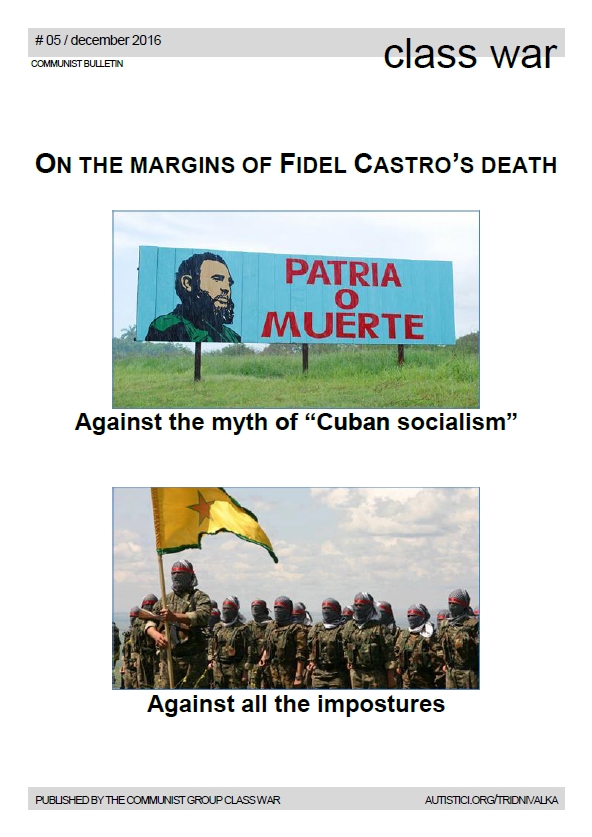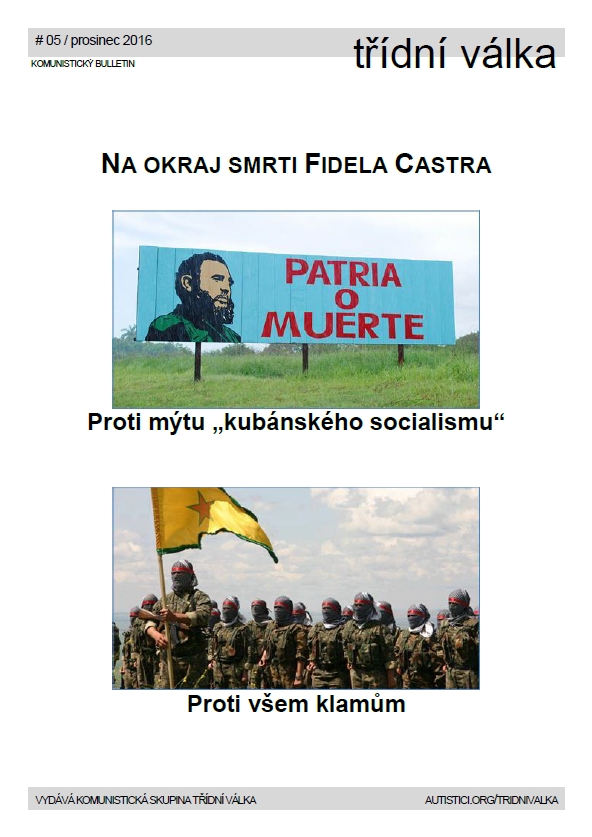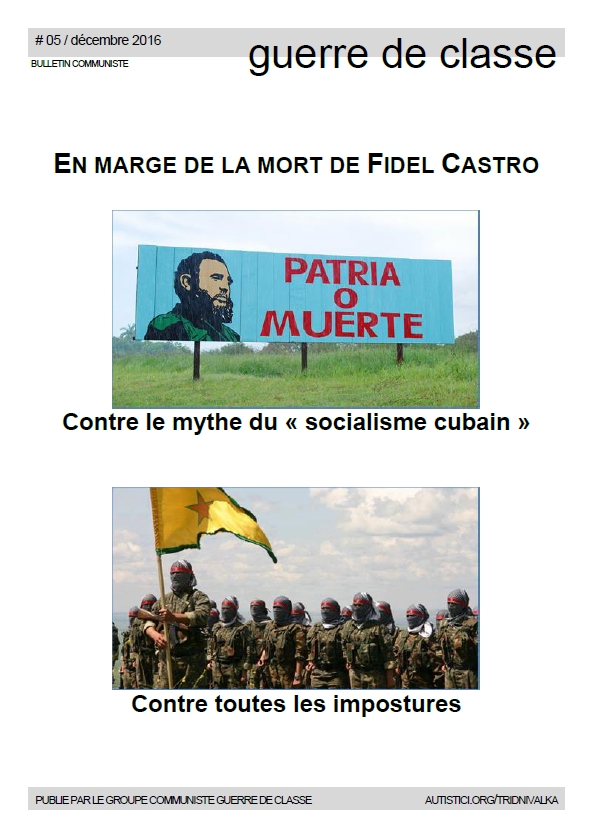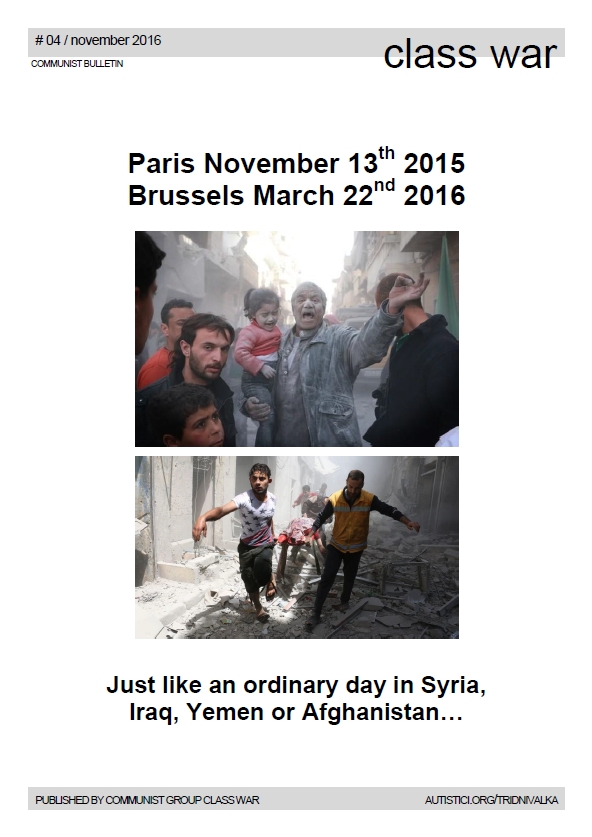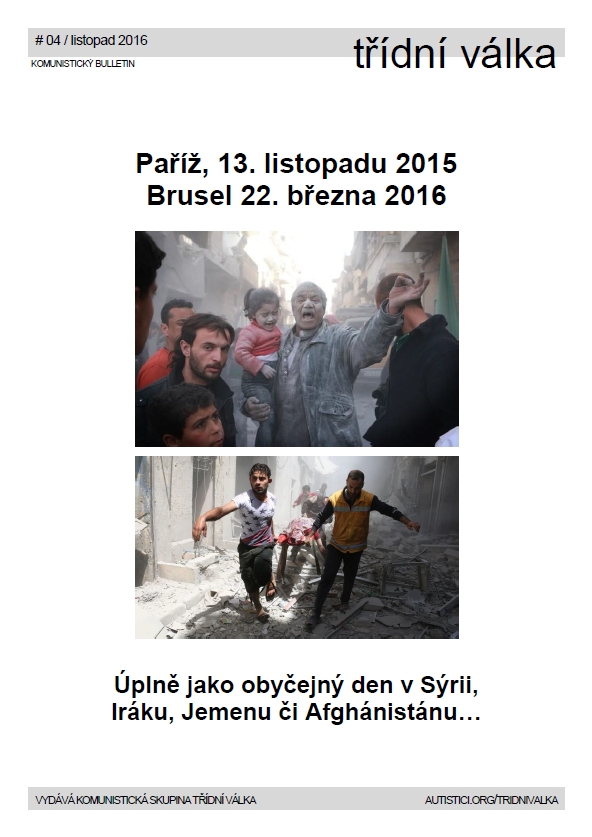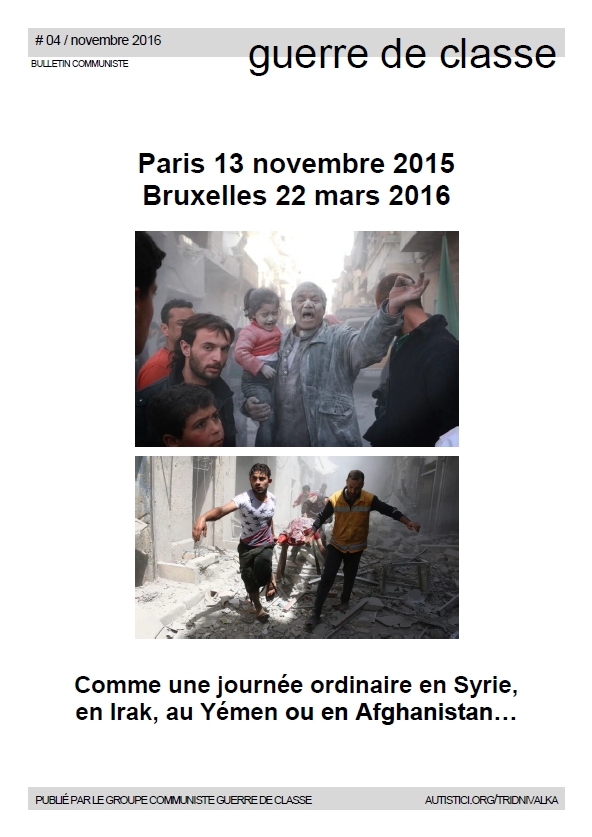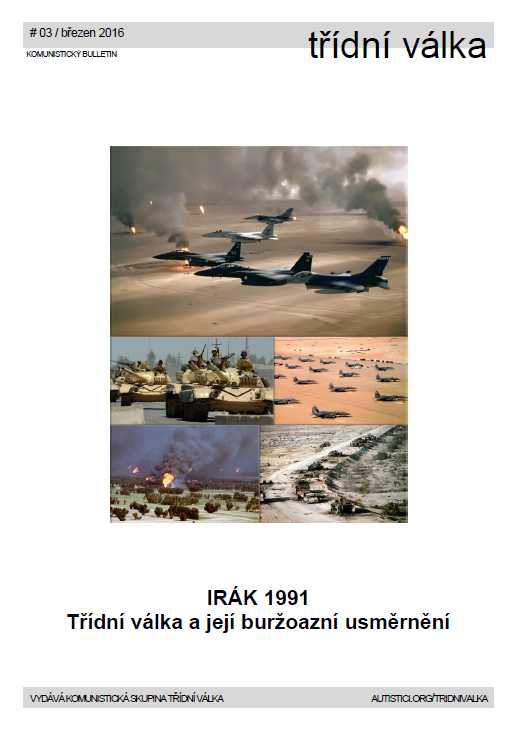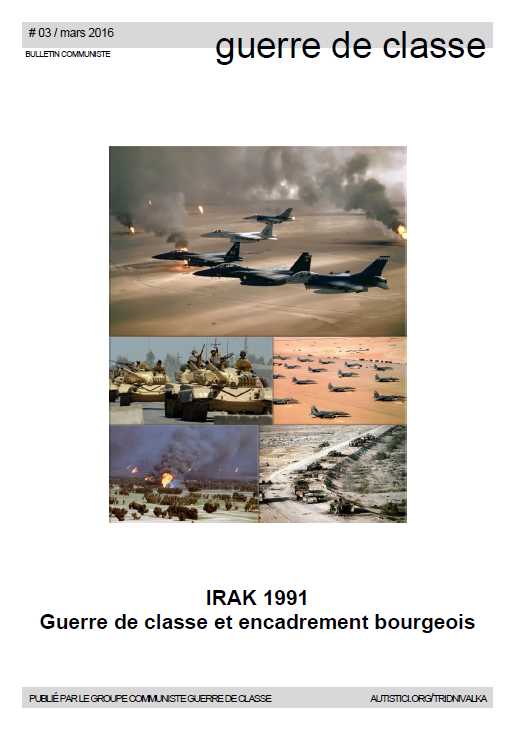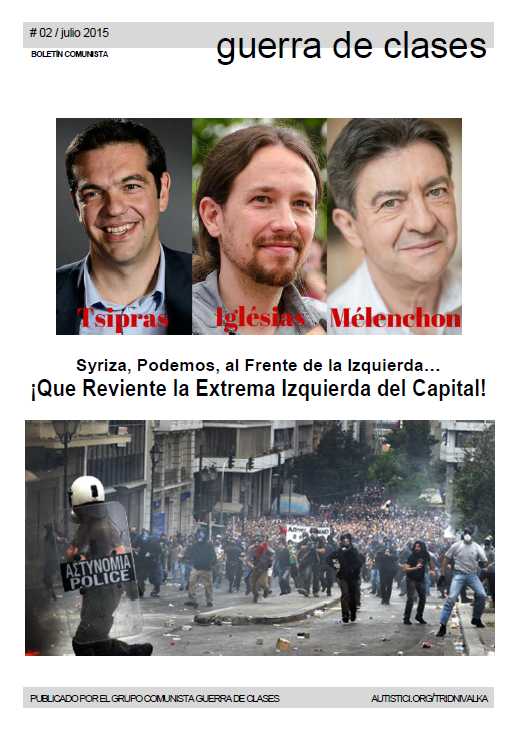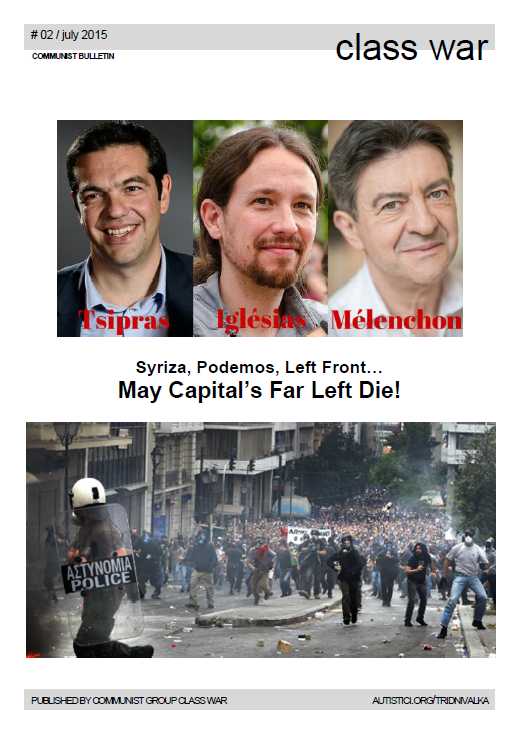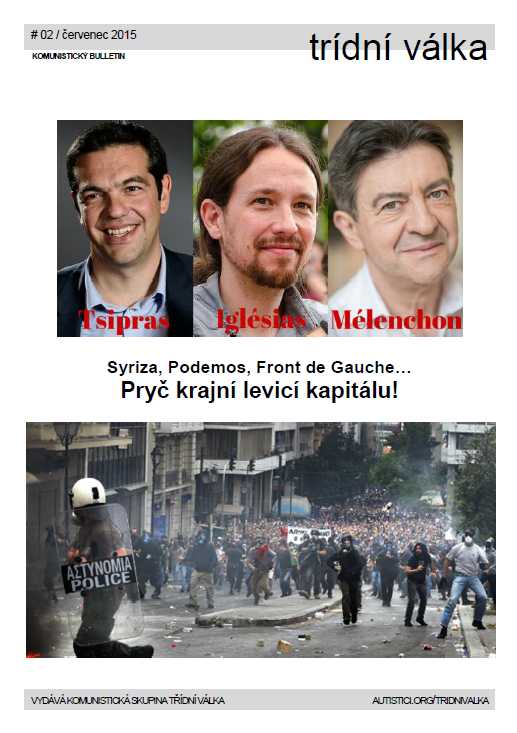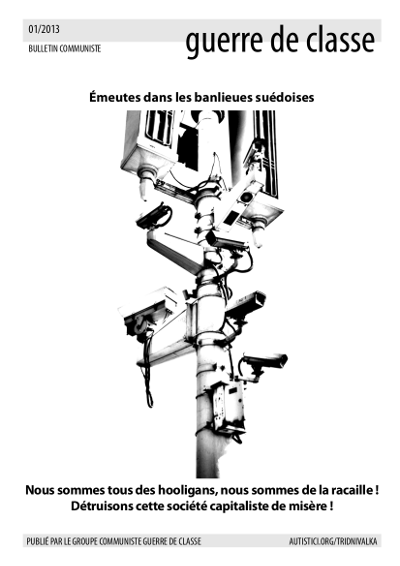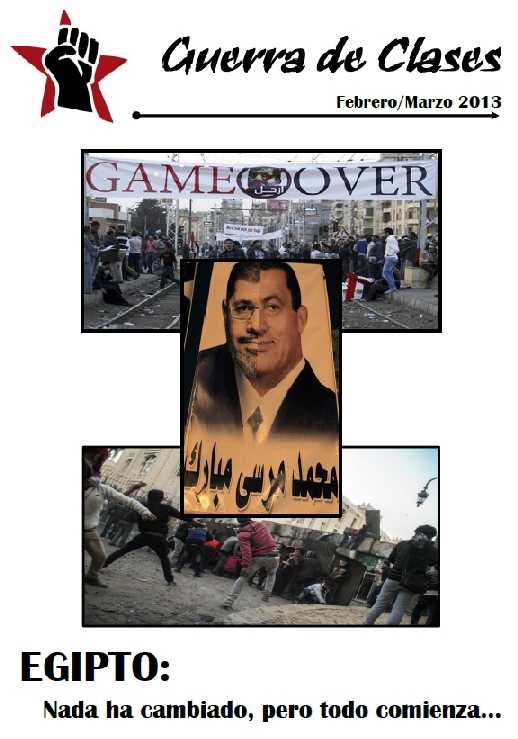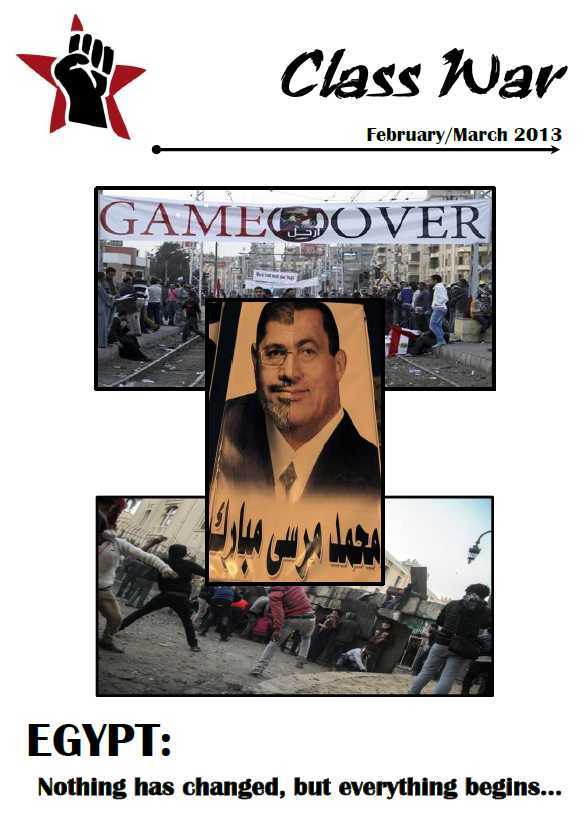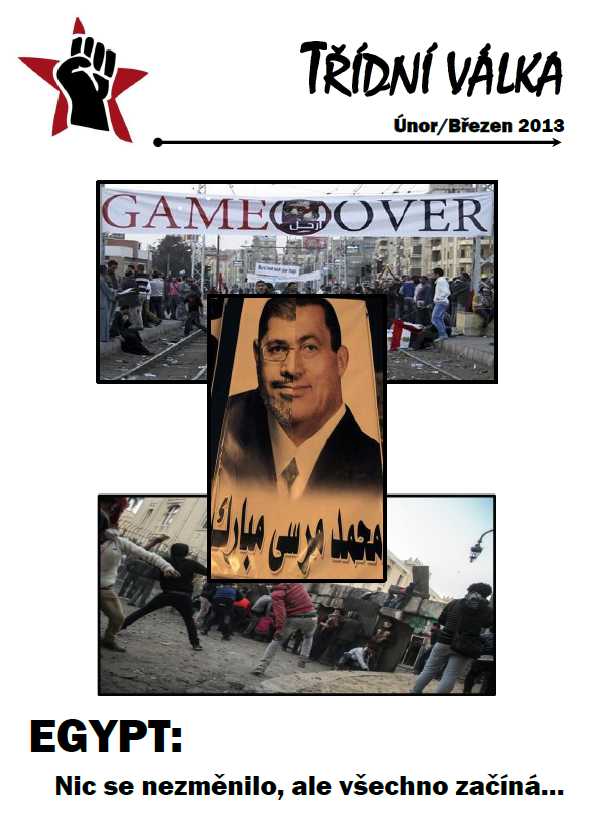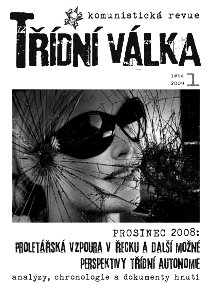Chapter II:
From Class Struggle to National Liberationist Counter-Revolution…
“Today any Czech must be more dear to us than a member of a foreign nation, even if this foreigner is a socialist. Today there are higher interests and there is also not a universal workers solidarity anymore. This is why the party does an all-national policy today directed to an establishment of the Czech state.”
a social democrat F. V. Krejčí
(November 25 1917, a public youth meeting in Prague)
But let’s return to the desintegration of the monarchy and establishment of the Czechoslovakian Republic. Since the middle of 1918 the Austro-Hungarian state apparatus more or less just helplessly watched an endless high-tide of strikes, hunger riots, desertions, mutinies and growing national liberation efforts of bourgeoisie in the Czech Lands, Slovakia, Poland, the Western Ukraine and the Balkans. The Entente powers had not been absolutely clear about the question of maintaining Austro-Hungary, but nevertheless they recognized the Czechoslovakian National Council in Paris (Masaryk, Beneš and Štefánik faction) as an official representative of Czech and Slovakian bourgeoisie and a de facto government of a would-be national state. This was mainly due to the Czechoslovakian Legion in Russia, which constituted an important counter-revolutionary force for the Entente, suppressing the social revolution and occupying cities along the Volga river, Siberia and all the Trans-Siberian Railway. (28) Another reason for this recognition was the doctrine of “the oppressed nations’ right to self-determination”, pushed forward by the US president, Woodrow Wilson, in an effort to build a nationalist barrier against the revolutionary flood. (29)
It was the awareness of an inavitable defeat of the monarchy and an effort to join the winning camp, what made a majority of Czech bourgeois factions to discard their Austro-philism and accept the effort to establish their own national state. An official rupture with the pro-Austrian policy was a speech of an Agrarian Party member and a chairman of the Czech Union of the Empire Council Deputies, František Staněk, and it was on October 2 1918. The national liberation faction and its representatives quickly gained a decisive role. Besides Masaryk’s foreign resistance it was an illegal organisation connected to this resistance, called Maffie, which had been trying to clandestinely influence the Czech bourgeois politics and public opinion and to spy for the Entente. (30)
On July 13 1918 the National Committee was re-organized according to the election results for the Empire Council from 1911, by which step bourgeois political parties affirmed their hegemony in the national liberation movement. The National Committee began to prepare for seizure of power and based on its model district and local National Committees were coming into existence. In order to strengthen its own position in the movement and to endow it with a potential to channel proletarian militancy, the Czechoslovakian Social Democratic Workers Party, who took a full part in the counter-revolutionary national liberation politics, additionally tried to create a certain counterweight and along with the Czechoslovakian Socialist Party established the Socialist Council (31) at the beginning of September 1918.
But the tendency of Czech bourgeois forces to adopt the national liberation line was also determined by an effort to contain the wave of proletarian revolution. Subversive direct actions of our class were not endangering only the Habsburg dynasty’s domination, but also the Capital’s domination as such and on all the sides of the imperialist war. In this situation the national liberation ideology proved to be an important weapon of bourgeois counter-revolution. So the national liberation movement in the Czech Lands and Slovakia also gradually got to be of an essential importance not only for the triumphing Entente powers, but also for the dying Austro-Hungarian monarchy. An establishment of a new national state and a wave of enthusiasm from a newly gained “national freedom” could prevent a diffusion of social revolution in this region or at least make it slower thus allowing bourgeois counter-revolution to isolate its epicentres more easily and absorb and crush them one by one.
This is why in 1918, when militancy and a revolutionary spirit affected a great part of the working class and this started to show first practical elements of its autonomy, which did not transform into clear programmatical conclusions, bourgeois socialists come into the class movement with all their might and resolution in order to use its weaknesses and recuperate it into the national liberation movement. Thus for example in 1918 for the first time during the whole war socialists organize May Day manifestations, but under the slogan “Socialist Nation”. When the Socialist Council was formed it was an expression of both an effort to recuperate and an increase of this effort by combining forces of historical Social Democracy.
To a certain extent it was not a too difficult task to redirect the proletarian movement from an overthrow of capitalism to a struggle for the national state. If this movement in many respects set for a journey of ruptures with capitalism, it had never made a conscious and programmatical rupture with Leftist parties and trade unions, which it had to bypass in the class struggles of preceding years – despite all its criticisms and discontent it had never directed the class struggle directly against them. Thus when these parties come back on the stage in an active way and pretend to be radical and militant, workers return into their embrace believing, that through their own militancy they made social democrats to act practically as a “pro-workers” political party again. But social democrats in fact just took an advantage of proletariat’s incapacity to recognize them as enemies and they redirected all the militancy towards another question, in which the class movement was unable to make a total rupture with the bourgeois ideology domination – the question of national liberation, which was one of the biggest weaknesses of the movement.
In the Czech Lands nationalism was the most powerful component of bourgeois ideology domination over workers for a long time. Both Czech and German bourgeoisie developed this ideology through overcoming feudal social relations. Nationalism was a tool for defence of their interests in a mutual competition; but also in a mutual co-operation against monarchy’s conservation efforts and the workers movement. Nationalism had been dividing our class already since the 19th century. The material basis of his success was a specific division of labour. Given the originally stronger position – both economical and political – of the German bourgeoisie, this division of labour partially favoured skilled “German” workers (however, by the end of the 19th century and beginning of the 20th this division disappeared and from the viewpoint of labour forces’ skillfullness there was not an important difference between “Czech” and “German” workers). On one hand a German national community was reproduced in this way and on the other a Czech national community was reproduced in an opposition against the dominant position of the German national community. Both were false, alienated and alienating communities dividing proletariat and setting it against its own interests antagonistic towards bourgeoisie.
It was not only the already mentioned Czech National Socialists Party, but also social democratic parties (both Czech and German), what expressed an influence of nationalism. A pre-war level of this influence can be clearly seen from nationalist riots, which took place at the end of September and beginning of October 1905 in Brno around a question of establishing a Czech university in this city. (32) During these riots it was mainly “German” and “Czech” workers, who fought in the streets, who was bleeding and dieing in fratricidal clashes, but also in confrontations with repressive forces. In a certain way, a rapid development of capitalist relations, the growth of the Czech national community connected to that development and the world war prepared conditions for both overcoming this national divide (in the form of an autonomous proletarian movement) and its deepening (in the form of the national liberation movement). The actively anti-Austrian part of the bourgeoisie got into a conflict with the state in a similar way as struggling proletarians did and in this conflict an illusory unity between Czech workers’ and bourgeois’ interests seemed to be affirmed and social-patriotic traditions of the idiotic self-negation as a class revived. And they revived up to the point of an important (but not total!) desintegration of the war-time proletarian movement into the Czech and the German movement and for a certain time and to a certain extent it turned to be its own exact opposite – it became a tool for bourgeois interests…
1. The General Strike of October 14 1918
“The national idea of new times is not the same national idea as before the war. …the national idea is gaining an appropriate social shading. Equality among nations – equality inside the nation!”
České slovo (the Czech Word)
(a National Socialist paper, October 1918)
In the autumn 1918 even the Austro-Hungarian state itself is in a state of decay, so frequent demonstrations, strikes, riots, sabotages and protest actions in fact got out of control and from its viewpoint were almost uncontainable. For example on October 7 there was a tram-drivers strike in Vienna because of wage demands and shortcomings in supplying. Strikers stopped scabing trams in the streets and removed fuses out of them, thus rendering them unable to ride. In the same day there were also strikes of railway yards workers in the town of Chomutov and about 10.000 Prague factory workers. 4.000 workers were marching towards the Prague governorate’s premises to protest against a bad state of supplying. On October 8 workers of the Prague sole works won their strike for a higher minimum wage and shorter hours. We could continue in this way endlessly, for similar events were on a daily agenda. In some plants capitalists even had to promise either free or very cheap lunches and snacks.
In this crisis Vienna authorities tried to take away from the Czech Lands all they could: especially food stuffs, coal, other raw materials and trains. The National Committee, which had already thought of itself as a new ruling power, did not want to run an empty shop. It wanted to keep under its own control as many means of production, sources and goods as possible and it also wanted to stop food supplyes for Austria and to use starvation as a weapon in negotiating an independent state with Vienna. This was why on October 9 the representative of the agrarian bourgeoisie, Antonín Švehla, suggested a protest action, which was to be organised by the Socialist Council. Already one day after the Czech Railway Employees Union Centre heard the Czech bourgeoisie’s call and started off a partial passive resistance. Instead of seizing food stuffs carriages and distributing food directly, without any exchange, among proletarians of all nationalities, railway workers just protected commodities for the Czech bourgeoisie and let the particular carriages to roam around railways within the Czech Lands borders.
The Socialist Council’s Action Committee (33) began to organize for October 14 1918 a one day general strike of Czech workers, which should have been the most massive mobilization in the Czech Lands directed against the Austro-Hungarian state up till that time. At the same time it was a part of an effort to channel proletariat’s struggle and a reflection of a level, to which this effort had been successful. Bourgeois socialists of all denominations also saw the general strike as an opportunity to weaken the so called “citizen camp” (the bourgeois Right-wing) and to become a leading faction in the national liberation movement. They understood very well, that only their traditional massive reformist parties were able to legitimize the nationalist project in workers eyes. As national socialist Jiří Stříbrný said:
“We, socialists, will not desert the united Czech front. But there is no reason for us not to say, that in the future we should be respected as a substantial part of the nation. We will not play an appendage role…” (34)
Though it was the war and cruel exploitation and hunger connected to it, what was the primary incentive of proletarian anger, the Socialist Council built its propaganda on an ideological junk still quite spoiling workers’ minds. It even strongly ideologically framed and channeled their class anger by and through nationalism. It endowed the strike with nationalist watchwords and objectives thus doing an enormous favour to counter-revolution, because it used a proletariat’s insufficient rupture with Capital and nationalist ideology to subordinate its struggle to the national liberationist one and to support false ideas in workers ranks, that an establishment of a national state would bring about essential changes in workers social position.
This was the meaning of the so called “Circular No. 2″, which instructed “socialist” parties’ officials how to run the strike. Besides the fact, that the Action Committee warned against violence and emphasized, that for the moment it is just “a rehearsal of preparedness for real fighting”, it also exhorted local party organizers to clearly show their “bourgeois” allies in the public speeches, that it is the Left and its social project, who should lead the national movement. This was why an independent Czechoslovakian republic should have been proclaimed at the mass meetings (35). Workers should have been asured that it would be a social democratic republic:
“Let’s emphasize a complete realization of democratic principles in our state and a resolution of important socialist problems. Let this part of the speech have not directly pronounced, but nevertheless totally clear tones of voice directed against those members of bourgeoisie, who think, they will be able to transfer their political and property privileges into the state in an unrestricted way.” (36)
Let’s quote several excerpts from the public proclamation of the Socialist Council’s Action Committee, just to have an idea of social democratic demagogy, which had nothing in common with class struggle and only urged “the working people” to defend nation’s liberty:
“Four terrible years of suffering are enough. Countless graves of our dearest ones, the working people turned into skeletons and mute horrors in our families drive us into a defence. We will not talk anymore to those, who were dictated to us by a foreign government power and it would be a humiliation of the nation to further negotiate with officials, who are not accountable to the nation and whose one hand was continuously promising us something and the other was continuously robbing us.”
“The time is ripe. We shook off the chains of dominated slaves. We roused for the independence. Out of our invincible will and sanctioned by all the democratic world we are proclaiming to stand here and today as executors of the new state sovereignty, as citizens of the free Czechoslovakian Republic. We are proclaiming, that any attempt at exporting and plundering our lands is the same robbery and the same crime against the sovereignty of our state as was an invasion to Belgia at the beginning of the war.”
“Those, who would defy this will of the working people, will be made accountable to the working people. (…) Our cause is the cause of all the world. Our cause has already gloriously triumphed and woe betide anyone, who would dare to hinder the aroused nation’s great march towards a new future!”
The “German” “working people” was mentioned only marginally as the one, who would surely “agree” to this “defence against hunger and death” (a true masterpiece of demagogy if we consider the fact, that the policy of Czech nationalists was to stop food supplies for German areas!). Only the extreme Left represented by Bohumír Šmeral was a miserable exception from general ignoring “German” proletarians. In the spirit of its own already pretty bruised Austro-Marxism it recognized as necessary to address also German speaking workers. Given the rapid radicalization of proletariat and ripenning of an worldwide revolutionary situation it believed, that destruction of the monarchy and formation of completely independent national states would be just a transitory stage of development. Naturally the social democratic Šmeralist Left saw itself as entitled to lead working class in this struggle, which equaled in its conception to a clash between two visions and ways of managing Capital. It understood, that in order to victoriously accomplish this clash an international co-operation of bourgeois Left-wing factions, which would establish an international federation of “socialist” republics, would be necessary. From these reasons it – unlike other bourgeois “socialists” – consciously wanted to avoid a chauvinistic rupture in international links of the workers movement. This was why Šmeral personally paid for printing a leaflet entitled „Czech Proletarians Address German Workers of Northern Bohemiag. It is characteristic to him that he also totally ignores proletariat’s real problems and interests and only tries to give a false impression, that the Czech national liberation movement – to which the Šmeralist Left participated – does not make an anti-German politics. Thus among other things it was said in the leaflet:
“In the given circumstances the prepared demonstrations of the Czech proletariat can gain a political character. In this case we inform You, that a participation of the socialist parties is a guarantee, that none of todays Czech proletariat’s manifestations can be an expression of a national chauvinistic tendency. While demanding the right for national self-determination for ourselves with all the consequences of the Czechoslovakian state’s independence, we recognize the same right also for You… Only representatives of the Czech and German proletariat are entitled in this historical time to decide in the future a mutual relation of both nationalities by a contractual way.” (37)
But the other social democrats and national socialists were not combining nationalist and socialists slogans in a kind of conscious “diabolic” plan for taming the class movement. On the contrary they acted in the spirit of their own beliefs and existing practice. Their idea of socialism had always been about reforming management of Capitalism. Economical, military, social and political horrors of the world war led them to believe, that Capitalism was at the end of its historical journey and the only thing which was necessary at the time was to gradually transform Capitalism into “Socialism” from ministerial seats. Bourgeois “socialists” had always shared the capitalist idea of progress and supported everything counter-revolutionary, what seemed to them as progressive, because it was bringing nearer the final goal of “Socialism”: one time it was the general suffrage, the other time it was this or that camp in the imperialist war and last time it was national liberation. As the social democratic paper Právo lidu wrote on October 13:
“This world war means an absolute breakup of the capitalist economical order, a total collapse of the capitalist, militarist and imperialist state and this is why it is high time to arrange new foundations for nations and their states.”
Even so far quite a reactionary leader of National Socialists, Václav Klofáč – faced with the war catastrophe and revolutionization of the world proletariat – declared in the party daily called České slovo:
“After 300 years our nation will do an examination, if it is a statist nation. Socialism accepts a great deal of responsibility for future times. The national idea of new times is not the same national idea as before the war. ( …) …the national idea is gaining an appropriate social shading. Equality among nations – equality inside the nation! (…) In the same way as Hus and Žižka complemented each other, the power of the party will support great human objectives, which we are working for and which we have fought for.”
The general strike of October 14 itself had a tremendous power and most of industrial centres joined it. The crucial place was Prague, where about 35.000 workers were on strike. But the inner city was occupied by the military armed to its teeth in order to prevent the proclamation of the republic. Chicken-hearted bourgeois “socialists” did not dare to publicly speak about an independent state and limited themselves to protests against exports of food stuffs. In the outskirts of Prague (Žižkov, Holešovice, Smíchov, Královské Vinohrady) Left-wing leaders plucked up their rhetorical courage, but refused a call for leading demonstrators into the centre of Prague. Thus in Prague itself the proclamation of the republic was eventually a complete disgrace. The proclamation turned to be a similar embarassement also in the town of Mladá Boleslav, where a gathering peacefully dispersed at an order of state authorities’ representative. (38) The strike took also place in Pilsen (at least 25.000 workers), České Budějovice, Strakonice, Kolín, Protivín, Poděbrady, Příbram, Nymburk, Chrudim, Hradec Králové, Česká Třebová. In Moravia all factories in Brno, Přerov, Třebíč, Moravian Ostrava and a carriage factory in Kopřivnice stopped work. In many places monarchical symbols were tore down from buildings. There was also a strike and a stormy mass meeting in Kladno (45.000 proletarians participated in it!), where it was possible to hear from workers ranks – waiting too long and in vain for a “revolutionary” speech of social democratic leaders – shouting: “Away with the war!” “Shame on the monarchy!” “Long live the Russian revolution!” “We want a socialist republic!”
The “most successful” proclamation of the Czechoslovakian Republic happened in the town of Písek, where a crowd of 4.000 workers dispersed many times outnumbered gendarmes and the mayor (!) subsequently announced, that the Republic was a fact and an atmosphere of all-national unity and reconcilliation hiding class contradictions filled the town. Soldiers, including several officers, were snatching off monarchical rosettes from their caps and replacing them with red and white ribbons or Slavic tricolours. Eventually this national crowd took over a building of the district office and hanged out a red and white flag. However, in the night four military companies from Pilsen marched into the town, immediately began to arrest people and all the pomp was over…
Thus the effort to overtake the Right-wing of the national liberation movement by proclaiming the Republic eventually turned to be a farce. The Socialist Council just loosened a valve of class anger and redirected its energy into its own social-patriotic limits. It allowed workers to strike, demonstrate, attack symbols of monarchy for one day, but it did not have courage to lead the whole action up to the originally set objective and given the dilettantish arrangement of the action it did not even intend to do so. The “citizen camp” was pretty well aware of these general strike’s weaknesses and strengths and properly used them to put “socialists” in their place of at best equal partners within the National Committee. As a Masarykian bourgeois politician, J. S. Machar, said:
“Nobody is resenting socialist parties for propagating the Republic – on the contrary, we could be grateful to them. (…) Remarkable revolutionaries, out of whose skulls the plan for proclaiming the Republic arouse, left… railways, telegraphs, telephones, post offices to the existing government… and the dear Austrian government was back on the other day along with gendarmes, troops, district authorities, etc. A lot of people is in prison now, officers, who snatched off their cockades…, will be brought to military courts…”
And what about bourgeois “socialists”? They subsequently admitted, through J. Stříbrný’s words, that the action was not prepared enough. And first of all they released a conciliatory and apologetic declaration:
“The Socialist Council resolutely raises an objection against attempts of individuals and some papers… to interpret the action… as an attempt to divide the united national ranks. The demonstration of the Czech socialist proletariat… strenghtened and encouraged the Czech people in its struggle for the Czechoslovakian democratic state, which we want to wage as before in an united array together with all political layers up to a total victory.”
Eventually, they found a scapegoat for the rest of the bourgeoisie and they blamed him for all their operatta-like steps to gain hegemony within the Czech national movement and for all blows proletariat pointlessly suffered from repressive forces. It was Bohumír Šmeral, who became this whipping boy blamed for a “bolshevik adventure” or for a Vienna sponsored attempt to cause a split in the national liberation movement, to provoke a bloodshed and thus give the state a pretext for persecution. Then the Socialist Council called upon him to give up any further activity in this association and Šmeral complied without any resistance.
However, the general strike was not just about a social-patriotic spectacle. Besides the fact, that our class almost generally stopped to work, there were many places, where it acted on its own and for its own interests. Unfortunately, it did so only partially, since it gave up its own autonomous activity in favour of the bourgeois parties’ (both Left and Right) initiative. For example: workers in Kladno de facto fraternized with a local Hungarian garrison and disarmed it:
“Workers in Poldi steelworks forced a management of the plant to let them elect their own delegates, who would oversee supplying workers with food stuffs. As soldiers of various nationalities were deployed to work in the factory, Germans and Hungarians were also elected as delegates and all of them sharply asserted our demands. A Hungarian soldier, comrade Tóth, was elected as a chairman of the delegates. Troops were sent to Kladno as well as to Prague and other industrial centres to suppress an obviously erupting revolt. Poldi delegates, who then held their clandestine meetings in the Workers House more frequently, decided, that comrade Tóth, as a Hungarian, would negotiate disarming the Hungarian garrison in Poldi. This was just before October 14 1918. Hungarian soldiers even with their commander were also fed up with the war and they were willing to lay down their arms. They just asked for a responsible member of the National Committee or the Socialist Council, whose authority was increasing in the last time, to come and asked for their weapons in the name of his respective body. We turned to our social democratic deputy Aust and asked him to take care about this business. This workers’ „representative“ actually drove us out. He was clutching his head and yelling, that we were loonies and psychos, whom he would never negotiate for.” (39)
Limits of proletariat’s self-activity – not only at the time of the general strike, but also before and after it – are quite clearly visible from this quotation. Though workers were forced to struggle and organize themselves in fact outside of unions and social democratic parties (40), they failed to fully recognize a counter-revolutionary nature of these institutions and to draw lessons for their own practice. So instead of taking the weapons themselves and keeping them for an inevitably approaching decisive confrontation between proletariat and bourgeoisie, they were ready to hand all the Hungarian garrison’s armament over to reactionary elements from the Socialist Council. The radical rhetoric of the national liberation movement (according to which the new Republic would automatically satisfy all workers’ needs) apparently played its role here.
Workers resumed work, but knowing that the situation had changed. Especially in places, where our class had been most militant for a long time, there was a complete change in the balance of powers between proletariat and bourgeoisie. The Austro-Hungarian state was in an agony, unable of any further repression and the Czechoslovakian national liberation movement was far from being so strong to control workplaces (factories, mines, steelworks, manors…) and order workers around. Thus for example in Kladensko region workers started again to normally attend shifts, but these shifts were not normal at all. No threat of compulsion, repression and punishment was hanging over the workers for the moment and thus they started to practically express a critique of labour as an alienated, alienating activity forced on them. They did all they could to disrupt a work process by unendurable slow-downs and sabotages, which sometimes stopped the whole plant. (41) This situation lasted until October 28 1918. An event, which happened in Ostravsko region on October 23, testifies to the fact, that Kladno was not the only place, where proletarians were aware of their own power. The minister of public works, knight Homann, had to come there in person to ask miners delegates to increase mining. They refused to do so, until militarization of labour would be lifted and supplying improved. Moreover they announced to the minister, that they stopped coal supply for Hungary (up till that time there were 400 carriages a day), because Hungary stopped food supplies for Ostravsko region.
Class struggle, however, took on also different forms. According to the news from a paper called Týdenní válečná kronika (the Weekly War Chronicle from October 17 1918) in Prague and other cities there was a self-organization of proletarians, who had to exchange their last clothes for food stuffs with countryside and urban profiteers. These “associations of the stripped”, which were said to be an initiative of soldiers coming back from the front to their homes, where there was nothing waiting for them but poverty, put together precise lists of speculating bourgeois. The purpose was to take a revenge on them, when favourable time would come. Bourgeois press and politicians (eg. V. Klofáč) crucified this form of self-organization as one of expressions of “bolshevik” (42) tendencies, which were increasingly engulfing proletariat as the Prague military command warned. The agrarian leader, Švehla, was seriously affraid of the fact, that “The hungry people can do something out of a sheer despair. (…) …the people got fanaticized…” Especially, when on October 24 press agencies brought non-confirmed news from Bulgary, that social revolution reached also Sophia, “Bolshevik workers fought a battle against the police and 3.000 people were killed.” Besides this there were embryos of workers and soldiers councils beginning to come into existence in Vienna and there were radical proletarians arming themselves in Budapest.
Similar fears were communicated to Berlin also by the German consul von Gebsattel, who wrote, that proletariat is furious about an unspoken expensiveness, hunger and exorbitant profits of usurers. This was why he was concerned especially about “security of property”. Although he believed, that first to go would be private property of German and German-Jewish bourgeoisies, he warned, that in case of an upheaval workers certainly would not leave property of Czech capitalists untouched.
2. The Political Changeover of October 28 1918
“At the beginning of this great work the National Committee, since now Your government, obliges You to keep Your behaviour and joy worthy of this great moment. Our liberators Masaryk and Wilson must not be disappointed in their belief, that they achieved freedom for the people, which is able to govern itself. Not a single act must spoil current great moments… Everyone of You must unconditionally respect everything, which is sacred for others. You must not infringe on personal freedom and private property. Submit unreservedly to the National Committee’ s order.”
The National Committee’s call to the Czechoslovakian people
On October 25 1918 the last Austrian government was appointed. The press called it “the ministry of liquidation”, because its main task was hand the power over to newly established national governments of individual monarchy’s lands in as orderly fashion as possible in order to avoid social revolution. This development on hand filled the National Committee with hopes and on the other it knew revolutionary moods of revolting proletariat, it knew, that soldiers on the Italian front refused to continue fighting for “the emperor and his family” and deserted en massé, which was at the same time a reason to be worried. So for the moment it was getting ready and waiting, “for a ripe plum to fall down to its hands,” as its members later claimed. Moreover Masaryk’s ex-patriate resistance discouraged it from any action (particularly an action, which would agree with a national state in the Austro-Hungarian framework) and ordered to wait for its instructions and negotiations with the Entente powers. The leadership of the ex-patriate resistance proclaimed itself to be a de facto Czechoslovakian government already in mid-October and Entente allies successively recognized it. However, the real development was somewhat different from plans of Masarykians, who supposed that the war would last till 1919 and it would be suitable to make a national liberationist coup only when the front would come closer to the Czech Lands.
On October 28 1918 an untimely piece of news began to spread in Prague and later in other Czech and Moravian cities, that Austro-Hungary surrendered and accepted all peace conditions suggested by Entente powers, including an independent development of all monarchy’s nations (43). Thanks to a joint effort of all warring bourgeois factions to stop social revolution the end of the war, which was brought about by proletariat’s revolutionary defeatism, thus appeared as a result of the Entente’s military triumph, which brought the bourgeois right of nations for self-determination to the Czechs and Slovaks. Workers in Prague hurtled from factories to the streets already before noon. They were enthusiastic about the end of the war and destroyed hated symbols of the Austro-Hungarian monarchy. However there was not only this classist moment present inside crowds as well as individual proletarians, but also a nationalist and reactionary one. There were red and white national flags fluttering over heads of the crowds, German notices were blackened and tore down, the Czechoslovakian Republic was celebrated. Revolutionary classist songs like “Red Flag” and “A million arms rised up in the darkness” could be heard along with a nationalist worn-out song, “Where is my home”, which would become the new state’s anthem.
The National Committee was more familiar with the local situation than the ex-patriate resistance, so it awaited events like these and hastily prepared itself for such a development. Sokol’s leader, Josef Scheiner, was charged with putting together armed detachments composed of Sokols, students and military veterans. Soon he was joined by Czech officers, who helped to obtain weapons and to win garrisons over to the nationalist side. Beside of this, members of the resistance secured contacts and support inside the gendarmery and the Prague police. Thus, when on October 28 masses of people got moving, the National Committee’s presidium – Antonín Švehla from the Agrarian Party, national democrat Alois Rašín, national socialist Jiří Stříbrný and social democrat František Soukup – quickly decided to act and make its own bourgeois, ie. national liberationist and political, “revolution”.
First they took over the Grain Institute, which was a key point in supplying. The National Committee thus could whenever stop food supplies for disobedient groups of inhabitants – for example: proletarians. The national liberationist leadership used this lever to achieve neutrality of the Prague military command and its co-operation in keeping bourgeois order. Prearranged Sokol patrols (soon reinforced by Boy Scouts and members of Workers Sport Associations) were immediately deployed in the streets – Rašín apprehended a nearing point of rupture and had them put on alert on October 27 in the evening. The National Committee also immediately strived to gain control over the police – Rašín ordered a high police official, Bienert, who collaborated with the resistance’s members, “Take over the police immediately. You will keep a total order, not a single sheet of glass in windows must be destroyed!”
Around noon the National Committee presidium’s members arrived in an open car at the foot of St. Wenceslaw statue in the centre of Prague, where they passionately announced, that they seized the power and called the people to keep its countenance and perfect order and fullfil all directions of the national liberationist leadership immediately. It was bourgeois socialists Stříbrný and Soukup, who addressed the crowds and felt obliged to promise not only freedom, but also social justice, in order to continuously keep a revolutionary appearance of their counter-revolutionary action. In Jiří Stříbrný words:
“The Czechoslovakian National Committee announces to you, that the free and independent Czechoslovakian state is a fact. After three hundred years we are free again… We greet Masaryk and Wilson, we greet our Legions! We will build a new future of national liberty and social justice on the ruins of tyranny. We do not know yet, what is in store for us, but we are not affraid of any sacrifices and means… We shall endure and overcome!”
Subsequently they issued an instruction from their headquarters, that all available brass bands go to the streets and through playing loud marches and patriotic songs contribute to as joyful mood as possible and to national ecstasy. The National Committe also tried to prevent a hyper-concentration of workers in the centre of Prague, since it was affraid of possible class actions. It would be difficult to get city centre proletarians, who had already stopped work, off the streets. But through the “socialist” parties it tried (with a partial success) to make workers from the outskirts to continue their work and not to march to the centre. It was promised that the next day would be a day off for proper celebrations of Czechoslovakian statehood. No riots or lootings really happened. Only sporadically Austrian officers were slapped, when they refused to put down the monarchy sign from their caps, and there was also a few anti-Semitic incidents. (44)
Foreign language military units located in Prague posed a certain trouble. The military command did not feel strong enough for an intervention, because more and more soldiers, who were formerly the most reliable ones (from Chebsko region and Hungary), were refusing to carry out orders. In spite of this fact nervous officers, who did not know, whether the monarchy was still existing, and what they should do, several times made their units to march against demonstrators. All these cases resulted in a peaceful agreement with national liberation officials and a withdrawal of the soldiers or a soldiers’ sabotage against orders. Eventually, the Sokols headed by Scheiner got into the military command’s building and forced the commanding general Kestřanek to agree with neutrality in political affairs, collaboration in keeping bourgeois order, immediate dismantling of plants’ militarization (45) and a withdrawal of non-Czech military units from the new state’s territory.
In the evening “the men of October 28″ ratified a text of the first law, through which they proclaimed the independent Czechoslovakian state and determined the National Committee as the only executioner of the state sovereignty, but at the same time kept in effect “all existing imperial and country laws and decrees” and “all municipal, state and regional authorities”. (46) The Czech bourgeoisie’s national “revolution” thus went exactly according to directives for handing the power over to new national governments, which were elaborated by the last liquidating Austrian government and consented by the emperor. The leader of the Maffie, Přemysl Šámal, clearly expressed his fear of possible consequences of a violent bourgeois revolution already on October 11 1918 in his letter to Beneš:
“A passive resistance is carried out. Simultaneously… we prepare everything for imposing a provisional government, which would take care about keeping order in the Czech Lands until your and allies’ arrival. We can not probably count on revolution at all. There is a fear, that due to the reign of hunger such a revolution would be redirected into bolshevik lines.”
Two episodes from October 28 give evidence of how much careful the Czech bourgeois “revolutionaries” were to change the form Capital’s political domination in a calm way and not to cause any society-wide conflict (47). When representatives of the National Committee went to “take the power” from hands of the Prague governor, they were not successful. The governor was in Vienna at the moment, so there was no “taking the power” and they had to visit him once more on October 29, when he returned to Prague. But they contracted with him only to “jointly run the public administration” in Bohemia. There was a similar situation in Brno. The Moravian governor was present, but he had no instructions from Vienna what to do, so even there the National Committee had to come for a second time to take the power and it contracted exactly the same treaty as in Prague. Only in the course of next days, when it had become clear, that Vienna would not take any counter-measures and there is no threat of a violent conflict, the National Committee took all the power.
It is self-evident, that in the then heated situation, when proletariat’s struggle was on the rise in the last two war years, Russia and the Ukraine were swept by social revolution and the collapsing monarchy was pregnant with inter-bourgeois clashes and class struggles, it was a primary task for the national liberationist leadership to maintain the capitalist order and gain peace for a consolidation of its own power, reconstruction and empowerment of the state. Be it even through old laws and authorities. Alois Rašín said it exactly:
“Our aim was to prevent a lawless situation, to keep all our administration running and to continue working on October 29 as if there was no revolution at all…”
No wonder, because it was not only Prague, where the news of “the surrender” caused a general upheaval (though later than in Prague). It was possible to see the same scenes of work stoppages in factories, mass demonstrations, destruction of state symbols, freeing deserters or “enemy” soldiers from prisons and a nationalist gush in all larger cities. In Pilsen workers from Škoda works and railway workers threw into a river a symbolical coffin with an inscription “War, Deutschland, Austria”, in which nationalism combined with an opposition against the capitalist war. In Brno the army had to disperse, “a suburban riffraff, which wanted to liberate prisoners from the Špilberk prison.” In all cities the desintegration of the Austro-Hungarian army culminated. The National Committee took over its Czech regiments and did not demobilize them, for they should have been used according to needs of the new state. But proletarians tired of the war did not want to stay in the army anymore or to keep discipline and subordination, so old units were largely unapplicable. According to the gendarmery general, Řezáč, who subordinated gendarmes to the National Committee, “at that time whole regiments scattered… and an unprecedented indiscipline set in the military. Personnel, which stayed because of a provision, refused to obey their officers and did not care about them at all. Those who stayed wondered around the city decorated with national symbols and regularly turned up only for mess, they promised to do something, but rarely kept their promises. It was very difficult to obtain men for patrols or units to be sent out from Prague.”
Of course, loyal repressive forces helped to manage the situation and hundreds of local National Committees helped to channel subversive class tendencies in all places. Local representatives of bourgeois political parties (including social democracy) assailed a more radical reform of the state apparatus and consciously breached the order, that all the imperial laws and authorities were to be kept in effect. They themselves acted as decisive power bodies of the state reconstituing itself: they unseated district governors, gendarmes and mayors, formed volunteer armed guards, but also carried out some social reforms as for example: an introduction of the eight hour working day, a minimum wage, etc. (48) In predominantly German regions this pacifying and repressive function was carried out by German bourgeoisie’s bodies, for National Committees had no chance to take the power there. (We can quote an example of Opava, where a deputation of a local NC, trying to take over a railway station, had to flee from an enraged German crowd and to hide in a caffé up to late night hours.)
On October 29 there was the already mentioned day off, when workers were supposed to celebrate an emergence of the independent state under a watchful control of social democratic and national socialist parties. A lot of mass meetings and manifestations took place, again under the banner of “the Socialist Nation”. A social democratic leader, Antonín Němec, explained to workers in the Prague People’s House, that the world war, “ended with the world revolution, in which emperors and kings lose their throns,” and new national republics came into existence and they would meet, “economical and social demands of the working people.” The day, when proletariat celebrated its own defeat was soon over and the National Committee addressed its own people again on October 30, “The Czechoslovakian National Committee turns to You with an urgent request to unconditionally resume work everywhere since tomorrow. At the same time it thanks for all the unforgettable enthusiasm and love expressed by the Czechoslovakian people while realizing the national ideal. However, it is inevitably necessary to return to business as usual and this is why we ask to prevent any gatherings of the people today.”
On November 14th the first meeting of the National Assembly (which came into existence by making the Prague National Committee six times larger) took place in Prague. Only on that day the republican form of the Czechoslovakian state was decided and the first government – “the nation-wide coalition government” – headed by the National Democratic Party’s leader, Karel Kramář (till that time he was the National Committee chairman), started off its activities. Tomáš Garrigue Masaryk, who was still abroad, was elected as a president. He returned home before Christmas 1918. Thus the national state of the Czech and Slovakian bourgeoisie, the Czechoslovakian Republic, was established.
3. Proletariat’s First Big Defeat
“To commemorate the days of the Czech resurrection from the suffering of three hundred years long oppresion, plant “Freedom Lime Trees” in remarkable places of the landscape.”
Právo lidu (October 30 1918)
Precisely this kind of nice activities was recommended by Social Democracy to “Czech” proletarians in the days following the changeover, when their Viennese brothers and sisters were entering their crucial revolutionary struggle. Indeed, there was an upheaval in Vienna (and not only there) and already on October 31 local proletariat formed its own armed force – the Red Guard, which counted about 6.000 people according to the first news. Thus while behind the “national” border our class was fighting in the first clashes against the police, some of “Czech” workers (useful idiots) instead of launching their own struggle as well, were walking around with spades, hoes and watering cans and planting “Freedom Lime Trees” to celebrate their own defeat! German consul’s fears, that, “The Viennese example might be infectious, so obviously a strong hand will be needed soon to tame excited minds,” unfortunately proved to be groundless… International links were interrupted. While in January 1918 the general strike immediately spread from Vienna to the Czech Lands, ten months later something like that was impossible.
The changeover carried out by the Czech bourgeoisie on October 28 1918 was a triumph of the national democratic counter-revolution over the international proletarian movement, which began to develope in the Czech Lands during the war years and through successive ruptures with the capitalist system headed towards class autonomy or establishing itself as the class and communist party and eventually making the communist revolution. While using its internal weaknesses – the insufficient rupture with social democracy and nationalism – the counter-revolution first brought this movement back under the control of bourgeois socialists, deprived it of its own internationalist character and made various “nationality” sectors of the working class into allies of “their own” respective bourgeoisies. Originally militant class movement from a large part turned into its exact opposite – into a social-patriotic mass, in which at first particularly “Czech” workers pushed forward “their own” bourgeoisie’s interests and in a tragicomic national-democratic community denied their own historical class interests.
However, even patriotic cretinism could not eliminate the class antagonism materialized amidst the all-national jamboree in practical contradictions. Let’s take one example. When the German bourgeoisie in Brno did not want to leave the city hall and hand it over to the National Committee, “Czech” proletarians let themselves to be used by “their own” bourgeoisie as a battering ram for conquering the power. Its Left-wing in the form of the Socialist Council declared a strike on November 4 1918. This strike was supposed to show not only to German councilors, but also to right-wing factions of the Czech bourgeoisie, who has got the power and ability to control and use workers. On Monday afternoon work was stopped in all Brno factories and about 50.000 workers gathered on Freedom Square, where they manifested for visions of left-wing factions of bourgeois politics how to manage Capital in the new state, pacify proletariat and integrate it into the capitalist society: for confiscation of war profits, expropriation of manors and big factories, full civil liberties and “the Socialist Republic”. On the other hand the same proletarians went beyond their role of a demonstrating herd of citizens, assigned to them by the Socialist Council, and decided to finish with hated politicians at the city hall, who managed workers’ misery during all the war and persecuted any attempts at resistance. Class anger streamed into the national framework and a part of the workers attacked the building of Old City Hall. Both German and Czech sectors of the rulling class were delighted by an intervention of the military and the police. Repressive forces saved the city hall from workers, but following this action the German bourgeoisie voluntarily surrendered its posts. As proletarians failed to make the same violent attack against the Czech bourgeoisie, in fact it helped to further strengthen its positions and deepen its own momentary defeat.
The working class in the newly emerged Czechoslovakian Republic (the CSR) was temporarily defeated by the bourgeois counter-revolution. Its majority to a certain extent and for a certain period of time believed – though never had stopped struggling altogether – in “national unity” and “people’s” or “non-class” democratic state, which would improve their position soon. This is exactly what Masaryk’s ex-patriate resistance promised in its Declaration of Independence, which was saying, that the Republic would, “exclude any special privileges and render class legislation impossible” and would carry out far-reaching social and economical reforms. In spite of this bourgeoisie did not doubt, that its victory is not definitive. So on one hand its leaders Kramář, Preiss, Rašín, Klofáč urge Beneš in Paris to have Entente troops immediately sent into the CSR to aid the consolidation of the Capital’s domination and on the other hand Kramář was promising workers a lower rate of exploitation in the new Republic, “it will not be a tragedy, if a capitalist will receive less, much less than before.”
Not only liberal politicians like T. G. Masaryk, who claimed, “Tábor is our programme,” (49) help the new capitalist state to keep this facade, but also social democrats of all kinds: “marxist” “comrades ministers” Habrman, Soukup, Winter as well as the “anarchist comrade minister” Vrbenský, who claimed the new government to be “revolutionary indeed” and himself to promote anarchist principles within this government. One of the reactionary principles propagated by so called “anarchists” was, “Free man in the free nation!” “Comrade member of parliament”, “anarchist” S. K. Neumann produced an extraordinary piece of stupid counter-revolutionary propaganda, whose purpose was to create confusion among proletarians by depriving terms “socialism” and “internationalism” of any revolutionary content and encouraging workers to peaceful and free labour for the new Republic. His article “Nationalism – Socialism” was so much disgusting and at the same time so typical for then Social Democracy, that we can not help ourselves quoting several excerpts of it. The temptation is too big:
” (…) Socialism is a question of freedom of all labourers and not a question of a proletarian power. Socialism can be born only through a slow evolution out of the truly democratic society and not out of passing power from spanking clean hands on dirty hands. (…) However, I can not even ask myself the question: First socialism or liberation of nations?, because something stronger than an individual, has already answered it. The answer is roared by all the world, by all our times. Even those in whose mouths it’s either laughable or depressing have been forced to propagate self-determination of nations. (…) Self-determination of nations is not a mere slogan in diplomats’ mouths, but also and primarily a goal in hearts and minds of millions – it is not a victory, but a defeat of nationalism, it is a success of fertile internationalism, which wants liberation, lasting peace and solidarity among all nations of the Earth and knows, that it can not achieve them, until a single nation is allowed to be oppressed by another nation. (…) Socialism is going to become an enormous agent in the world of tomorrow, because it is going to be transfered from hands of the organized proletariat into hands of the thinking humankind and while gaining a generally human character, it is going to lose its dependance on a success or a failure of a tiny workers’ action. Today, however, it has no other possibility than to wait for settling the main question and slowly orient itself in what is going to come. It will probably have to give up as many “revolutionary” slogans as “scientific” ones and to rebirth itself, to grow naturally out of the new situation. The war, Russian events and other things have taught us, that not even socialism can bang its head against a brick wall. Though I still consider myself to be a radical socialist, I reckon, that precisely current time would be the least favourable one for attempts at this kind of banging. They are, however, going to seem easier and easier. Many of those who were hiding themselves in the right moment and kept their mouths shut will noisily step out to the light, but if the people listens to them, there could be only one result: a dangerous chaos…”
All then modifications of combining national self-determination and socialism – whatever Left-wing faction of bourgeois politics came up with them – found their expression in calling for “the Czechoslovakian Socialist Republic”. The content of this slogan was more or less common for all the factions. It was an old social democratic doctrine of a peaceful seizure of power in a bourgeois state by Left-wing parties through parliament and a subsequent gradual socialization of economy, which has nothing in common with the Communist revolution heading towards destruction of private property, economy and wage labour. Even the most radical forms of Social Democracy, which were just starting to form themselves and which would talk about revolution instead of peaceful evolution, would hinder an organic internationalist centralization of proletariat with the counter-revolutionary concept of the right of nations for self-determination, to which they were tying socialist revolution. Their aim of a national socialist republics’ federation in fact copied the division of the world and proletariat by Capital.
All these social democratic combinations of nationalism and socialism (while the attitude represented by S. K. Neumann was at the time on the Right and an attitude of bolshevik adherents on the extreme Left of Social Democracy) enormously aided the international counter-revolution: an attempt at proletariat’s truly internationalist revolutionary upheaval was postponed by two years and meanwhile the rulling class gained time and peace necessary for suppresing proletarian movements in Russia (through the Czechoslovakian Legion), Hungary, Slovakia and the Carpathian Ukraine and for consolidating its own positions.
4. National Liberation As a Part of the Imperialist Conflict
“We will conquer Budapest and force the Hungarians to pay for damages and expenditures. We will take locomotives, carriages, the Danube fleet and war material.”
T. G. Masaryk (1919)
It would be, however, quite undialectical to see only the united action of the international bourgeoisie against revolting proletariat and overlook, that at the same moment distinct bourgeois factions fought a hard competition struggle among each other. In the Habsburg monarchy, which was breathing its last, it was primarily a competition among national bourgeois factions (Austro-German, Hungarian, Czech, Slovakian, Polish, Ukrainian, Southern-Slavic, Jewish and Rumanian), which were striving to grab as many natural sources and means of production at the expense of other factions with a prospect of an early establishment of their own national states. Later on a conflict among factions representing different visions of managing capitalist relations – the conflict between radical Social Democracy (= Bolshevism) with its reactionary utopia of National Workers Councils Republics and classical free market bourgeoisie – was added.
4.1. Annexation of the German Provincies
Even the so called historical Czech Lands were no exception. There were roughly 75% of all the Austro-Hungarian industry concentrated there. 2/3 of this number, however, laid on predominantly German-speaking territories and were owned by the German bourgeoisie. Of course, the Czech bourgeoisie was eminently interested in integrating these economicly important territories into its new state. A part of the Austro-German bourgeoisie, however, did not share this project – it was especially affraid of losing its own political influence and perhaps even their property. Which was the reason, why it also claimed its right for national self-determination, postulated by the US president Wilson as a necessary part of the post-war re-arrangement, and intended to form its own national unit (Deutschösterreich), which would be either an autonomous land within a framework of the reformed grouping of states along the Danube river or a part of the German empire. The irredentist movement of German nationalists, nevertheless, did not represent interests of the whole Austro-German bourgeoisie. Especially German heavy and textile industries’ tycoons, who were linked with markets in Czech regions and affraid of a greater-German competition, put their hands off the German national liberation. (50) In the same way many proletarians were more or less indifferent to the question, in which capitalist state they would live. This is why German nationalists were unable of important and determined resistance.
The wartime proletarian movement in German provincies suffered from identical weaknesses as its “Czech” counterpart: an insufficient rupture with historical Social Democracy and nationalism. German nationalist propaganda – produced also by the German Social Democratic Party in the Czech Lands headed by Josef Seliger – strived to use dissatisfaction of proletarians, who, particularly in the Northern Bohemian, often mountainous, very industrial, unfavourable for an agricultural production, German areas, enormously suffered from hunger – their situation was perhaps the worst one in the whole Czech Lands. The Czech bourgeoisie aggravated this situation even more, because at least since October 1918 it did everything it could to limit food stuffs supplies for border areas, Austria itself (51), but also for soldiers on the front. Antonín Švehla, the representative of the agrarian bourgeoisie and the president of the Land’s Agricultural Council, shrouded this policy of an economic and political speculation with hunger in slogans about nourishing the nation, which he said to be a primary all-national task and even founded a charity organization called the Czech Heart, which was supposed to take care of food and other needs of the poorest proletarians. But workers continued starving even in the Czech hinterland. German nationalists used this situation to stir up anti-Czech chauvinism and called for a violent seizure of food stuffs belonging to all “the Czechs” living on the German territory, even though local Czech speaking workers were starving exactly the same as “German” ones and German bourgeoises were as well off as their Czech counterparts.
When the independent Czechoslovakian state came into existence on October 28 1918, shortly afterwards the German bourgeoisie proclaimed an independence of German provincies Deutschböhmen (Northern and Western Bohemia) and Sudetenland (North-Eastern Bohemia, Northern Moravia and Silesia), a district Deutschsüdmähren (Southern Moravia) and a region Böhmerwaldgau (Southern Bohemia). Neither the establishment of the CSR led to an absolute end of our class’s movement (though a majority of proletarians was paralyzed by it for a certain time) nor the proclamation of independent German provincies resulted in a complete triumph of counter-revolution. Already on November 2 and 3 1918 there were wild hunger riots in Ústí nad Labem, Chomutov, Liberec and Sokolov (Falknov) and on November 5 there was another one in Ostrava. Proletarians of all nationalities rolled down the streets of these cities and towns and through looting shops directly appropriated their life needs (at the same time for example proletariat from Moravian Slovácko expropriated stocks in manors, while an overwhelming majority of “Czech” workers was still celebrating national liberty and a majority of “German” workers was only looking forward to this kind of liberty). Faced with the proletariat attacking private property both competing bourgeois factions (represented by the provincial German government and the Czechoslovakian government) did not hesitate to join forces in order to defend the domination of Capital. Where German bourgeoisie’s own repressive forces were not enough to violently suppress hunger riots and looting, it did not hesitate to call in Czech military units and the Czech bourgeoisie willingly sent them!
In fact, it was the CSR, who was to contribute to the victory of national liberationist counter-revolution and to the pacification of a great part of the “German” working class in German areas. The Entente powers did not want to allow merging of these industrial areas with German Austria. They were affraid of their later merging with Germany itself, which they wanted to weaken and eliminate as a competitor in a struggle for markets and profits. This is why the Czech bourgeoisie was allowed to realize its own imperialist project, which was based on the imperative of the Masarykian national liberation ideology, that the new state must not be a “weakling”. Since November 27 till mid-December 1918 a hastily formed Czechoslovakian army systematicly occupied and annexed above mentioned German provincies, while engaging in occasional clashes with “German” population (for example in Most six German-speaking inhabitants were shot dead and in Moravská Třebová four women and a small boy died). Many times it was undoubtedly an attempt of “German” proletarians to defend themselves against an arrival of a new repressive force, for nationalist politicians openly warned “German” workers against an armed resistance. However, without their own and clear revolutionary perspective “German” proletarians anyway ended in an eager embrace of their own exploiters – the German bourgeoisie. Seeing, that their policy has no chance for success and is even sabotaged by a substantial part of German businessmen, German nationalist leaders and their powerless provincial government fled to Vienna.
How much they abandoned their own class interests and threw their arms around German capitalists is testified by a participation of thousands workers at events of March 4 1919. German bourgeoisie’s political parties headed by the Social Democracy and trade unions organized for that day their own version of the “Czech” general strike of October 14 1918. It was a general strike and demonstrations to protest against the fact, that the CSR render it impossible to take part in elections for the German Austria’s parliament, whose meeting started on that day. Seliger, the social democratic leader, was passionately destroying class consciousness of “German” workers at a manifestation in Teplice, as he was talking about the Germans’ love to their nation, liberty and rights and tried to draw the victorious powers’ attention to an “injustice against the Germans in the Czech Lands”. In the spirit of their counter-revolutionary political tradition social democrats were imposing an intransigent struggle for national interests, for German bourgeoisie’s interests, while talking about socialism:
“We are not united by a hate against the Czech nation, whom we wish its liberation… We want to persist in our struggle for the right for self-determination… We want to enter together (…) great, free, socialist Germany!”
The Czechoslovakian army proved to be a far more effective repressive force than the Austro-Hungarian army was on October 14 1918. It successfully dispersed the demonstrations, in seven cities and towns (Kadaň, Šternberk, Karlovy Vary, Cheb, Hostinné, Stříbro…) by opening fire into the crowds. The result was 54 dead people (among them 20 women, 2 youngsters, 3 children from 11 to 13 years old) and 104 seriously wounded persons. The result was, however, also strengthening nationalism in the ranks of “German” workers, a consolidation of the ideological national community with “their own” bourgeoisie, which would lead, among other things, to an abstention of German speaking proletariat’s important part from later struggles of their Czech and Slovakian speaking class brothers and sisters.
4.2. The War Against Poland
Following the proclamation of the independent Czechoslovakian state it was not the National Committee that came into existence in the town of Těšín, but the Polish National Council, which declared the whole region of Těšínsko as a Polish one, for there were more Polish people living in this nationally mixed area than the Czechs. The Polish military occupied the region during the night between October 31 and November 1 1918. On January 23 1919 Masaryk ordered a military assault against Poland, during which the Czechoslovakian army within a week occupied a greater part of Těšínsko region (with coal mines and the only good railway to Slovakia) at the cost of 45 dead on its own side (52). This time Czechoslovakia did not receive a support from its allies and its military had to withdraw. The CSR succeeded in getting a more favourable line of demarcation with Poland, but it was far from obtaining everything it wanted. It was alloted only Fryštát and Karviná districts and just a part of the key railway through Bohumín to Čadca.
4.3. The Slovakian Campaign And War Against Hungary
The CSR held similar expansionist whims also towards Hungary. At first the Czechoslovakian army led quite unsuccessful struggles against the Hungarian army, in which the control over Slovakia was at stake. However, on December 3 1918 the Entente allies forced Hungary to withdraw its army out of Slovakia, but did not specify, which regions should have been abandoned by Hungary, so the Southern border remained unclear. The Prague government was affraid of a Budapest suggested plebiscite on the common border, because there was no important anti-Hungarian opposition in Southern Slovakia, which was a major agricultural area. Only on December 24 1918 allies set also the Southern border and forced Hungary to withdraw its troops behind it. So the army of the Czech bourgeoisie was able to finish the annexation of Slovakia (alltogether 200 Czechoslovakian soldiers fell) only in January 1919.
Following an establishment of the Hungarian Council Republic on March 21 1919 Kramář and Beneš persuaded the French government, that the CSR was able to play the role of an anti-Bolshevik bastion, but for this purpose it had to achieve a connection with Rumania in order to jointly cut the Council Republic from a possible connection with Soviet Russia and thus it had to militarily occupy and annex a so far Hungarian territory of the Carpathian Ukraine. Marshal Foch agreed and so on April 27 1919 the Czechoslovakian army started to advance Eastwards and occupied the Carpathian Ukraine. On its way it “accidentaly” crossed the Hungarian border and tried to occupy the Szalgótarján coal basin and march against Miskolc. The Hungarian Red Army, however, put it to flight and it was its turn to occupy 2/3 of the Slovakian territory, which it left again following a diplomatic pressure of the allies. We can not doubt about imperialist aims of the war against Hungary, which left 1.018 dead soldiers on the Czechoslovakian side, when we read Masaryk’s notes from that time:
“With all our forces we will drive their invasion back and use the victory for our own aims. We will conquer Budapest and force the Hungarians to pay for damages and expenditures. We will take locomotives, carriages, the Danube fleet and war material.”
4.4. Impacts of the War Conflicts And Nationalism on the Proletariat
All these miniscule forms of the imperialist war in the first years of the independent Czechoslovakian state necessarily had their impacts on the working class. They contributed to stiring up nationalist rage and to crushing proletariat into atoms of bourgeois national communities. So the German speaking part of the working class was under the leadership of the German Social Democracy drawn in the nationalist opposition against the CSR, which would be soon developed by Nazis.
Both German provincies and Těšínsko (53) became settings of many national riots provoked by Czech, Slovakian, German and Polish nationalists, who were always able to mobilize a smaller part of workers to act against their own interests. Various bourgeois factions and forces intentionally stired up those riots with an obvious aim to strengthen an alienated national community against a real proletarian community of struggle, which was understood as an “anti-national”, “Bolshevik” or “Jewish” one.
So for example ultra-nationalist parts of demobilized Czechoslovakian legionaries were roaming in gangs through German areas in Bohemia, destroying local German memorials and sights and provoking clashes with the “German” population. In Cheb, as well as for example in Aš, even a local military garrison took part in tearing down a monument of the emperor Josef II., which provoked gunfights and bloody clashes with German nationalists. In June 1920 there nationalist skirmishes in Jihlava, which took several people’s lives. In October of the same year there were again bloody conflicts of the Czechoslovakian military against the “German” population in Teplice and Cheb. In November the clashes spilled over to Prague, where enraged Czech nationalists violently occupied a building of the German Theatre, which deed was hallowed afterwards by Czech authorities. It is no wonder, if we take into account, that the Prague mayor was at the time Karel Baxa, well-known for his anti-German and anti-Semitic attitudes; for example: in 1922 he forbade German songs and Gipsy music in Prague pubs. In the summer 1921 the whole trains of Czech national chauvinists set off for German border areas, where they organized demonstrations and provoked violent clashes. In Ústí nad Labem two Germans were killed and many others injured during such a clash.
The most reactionary legionaries led by Čeřenský formed the Czechoslovakian Legionaries Cohort, which besides anti-German and anti-Jewish pogroms organized breaking of militant proletarian meetings and strikes. Soon it would become together with a part of the Sokol members a promoter and a bearer of Czech fascism in a form of the National Movement. Similar groupings were developing also on the German side of the national divide in order to eventually merge in the Nazi party, the DNSAP (54).
All these nationalist and fascist movements were themselves favoured by proletariat’s weakness, they were expressions of an inability of its significant – but so far not a decisive – part to realize its own historical interests and to organize themselves as a class. They also expressed weaknesses beared by the more conscious and militant part of our class – precisely these weaknesses were later ideologically exploited by fascists, when they took over a certain form of radical Social Democracy and developed the struggle for the right of nations to self-determination into a radical nationalism. Following the definitive defeat of the proletarian movement at the end of 1920 and beginning of 1921 all those expressions of counter-revolution had an immense political and social profit from the mentioned weaknesses, for due to them they were able to tame and dominate an overwhelming majority of workers. But we are now moving faster in our analysis than historical events themselves…

